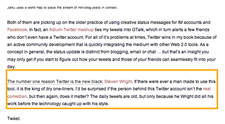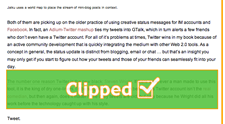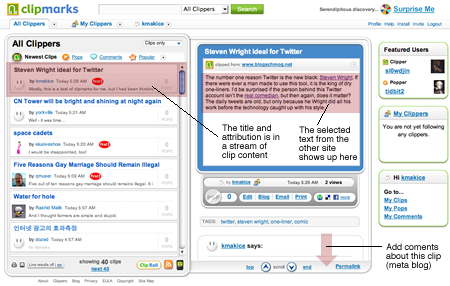The application is about a year old, but a major upgrade late last February put Clipmarks—a browser tool that allows you to save portions of web content for later review—into a new stratosphere of functional social networking. ClipMarks 2.0 is available as a Firefox extension, as well as plug-ins for Flock and Internet Explorer. There are other social apps in this area, but it remains to be seen if they will capture the same kind of interest ClipMarks has had since their 2007 upgrade.

ClipMarks adds a button at the top of the browser to toggle clipping mode on or off.
Over the past couple months, Eric Goldstein, co-founder of ClipMarks, has granted interviews to Robert Scoble (The Scoble Show) and John Jantsch (Duct Tape Marketing). Goldstein says his inspiration for the app comes from his family.
His dad sends cut-out portions of newspapers and magazines to Eric each week, and his mother highlights her favorite sentences with a marker. Eric’s grandfather used to talk to the television when news came on, particularly when he didn’t like it, and he publicist wife would clip stories to assemble a daily portfolio of media references to her clients. Having graduated law school and passed the bar exam, Goldstein himself is a near-lawyer who takes from that experience the habits of reviewing documents and marking the important bits. Noting that consuming web content is widespread, Goldstein wondered why wasn’t an easy way to perform the same kinds of clipping tasks with electronic content.
There is a specific thing about the brain that I’ve learned that has a great parallel with clipping. It turns out everybody has a RAS, as we call it. A reticular activating system. Your RAS is what literally alerts you when you find something interesting. You know when your daydreaming, reading an article by spacing out, and the Boom! you come back to life? You don’t know why, but there literally is a reason. Your RAS just said, “Wake up.” I want people to be able to clip those moments.
From The Scoble Show
Unlike other social bookmarking tools (like del.icio.us and ma.gnolia), these marks aren’t constrained to the entire page. Clipmarks allow the important content within a page—including images and embedded movies—to be captured along with the same page URL that is the focus of other services. “In some respects,” said Goldstein to Scoble, “this is the evolution of bookmarks to a specific level.”

In clipping mode, an orange bar appears at the top of the content frame with controls to save, blog, email or print.


To clip content, select the block of content you want and click.
ClipMarks is also a community. Each logged-in member can review and interact with the stream of clipmarks coming in. Each mark can be set to private or public status, and other public clipmarks can be saved to become part of your own collection with custom tagging that makes sense to you. There is direct interaction with each clip in the form of remarks by the clip’s author and a thread of reader comments about the clip. You can also follow the work of other authors and rate the quality of their content with “pops” (votes to validate a clip). Goldstein says his dream is to create a social world where people can exchange and consume clips—niche experts distilling the mass of information into digestible nuggets for the rest of the world.

Once saved, the clipmark acts like a little web page containing only the relevant content.
The benefits of the tool are potentially huge. Not only is this a great way to browse content on the Internet by letting it come to you, but it is relatively easy to identify users interested enough in that topic to clip and comment about it. More importantly for academics, it is a wonderful application to aid in consumption of academic journals and abstracts available online. I could see spending a day in the JCMC or FirstMonday and clipping all of the relevant bits for later review. There is a nod to bloggers by including a “Blog” button to integrate a clip with a blog entry, but it would be even nicer if there were a “Wiki” button, too, to help assemble content for later editing. ClipMarks is a utility that is quickly and easily integrating itself into my daily online routines.
2 replies on “Clipmarks”
My former father-in-aw would cut articles and news items from the papers and mail them to his daughter.
The idea, I thought, was to let her know he was on top of things and she was missing a lot be being married to me….
I find 2/3 of those things clipped and put on the ClipMark page to be trivial, silly, of stupid. So there.
Jury is still out for me on its effectiveness as a community tool, but I do find it handy for saving things of interest in context. I am very anxious to try it out as a research tool, but honestly I haven’t done much more than post, pop and save. The organizational features are going to make or break this for me.